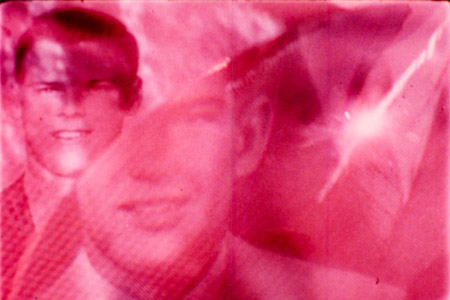It seems that it has taken many viewers, even those deeply sympathetic to the avant-garde, some 40 to 50 years to come to grips with the complexity of Bruce Baillie’s cinema. There are several possible reasons for this. Baillie’s place in the history of experimental film has long been established. He was one of the original founders of both the Canyon Cinema distribution cooperative and the screening series that evolved into the San Francisco Cinematheque, and several of his films, such as Castro Street (1966) and Quixote (1964-67), are canonical classics.
However, as I think many of us know, avant-garde film fell out of fashion in certain key critical and academic circles for a period of time, in the 1980s and ’90s. Of course, filmmakers, programmers, preservationists, and other devotees kept the flame burning. But the rekindling of interest within the critical community over the past 20 or so years has been, like all such retroactive re-engagements, particular, organized by categories of thought and threads of aesthetic lineage that assert themselves more or less forcefully, as a “usable past” ready to answer specific questions that appear germane to the present.
Baillie, by contrast, was no polemicist. Aside from a few very personal, somewhat cryptic remarks tying his films to his own amalgam of Eastern spiritualities, and some quite forthcoming details regarding his superb craftsmanship, Baillie has never built a discourse around his cinema or tried to tell others what it meant.
Some films and filmmakers seemed to speak more readily than others to newly stoked interests in phenomenology, early cinematic forms, spatial and linguistic deconstruction, and other, more overt modernist methodologies. What’s more, many of the most important filmmakers of the 1960s and ’70s – Stan Brakhage, Hollis Frampton, Peter Kubelka, Ken Jacobs, Jonas Mekas, Yvonne Rainer, Paul Sharits, Jack Smith, Michael Snow—were both theorists and polemicists, clarifying for once-skeptical academics just what it was they were doing.
Baillie, by contrast, was no polemicist. Aside from a few very personal, somewhat cryptic remarks tying his films to his own amalgam of Eastern spiritualities, and some quite forthcoming details regarding his superb craftsmanship, Baillie has never built a discourse around his cinema or tried to tell others what it meant. Furthermore, historically speaking, one could paradoxically call Baillie a victim of his own originality. Even nearly half a century on, one is hard-pressed to classify his films or categorize them within some trend or “school.” Much like Brakhage, Baillie forged his own vision; but even more so, Baillie often seems to have devised new working methods and stylistic textures with each and every film. (In this respect, Baillie is a lot like miscategorized “structuralist” Ernie Gehr.)
Of course there is great consistency to Baillie’s work. His color palette is second to none; only Nathaniel Dorsky comes close in terms of capturing the unique temperature and palpable radiance of Northern California sunlight. Baillie has also been one of a handful of avant-garde masters whose keen compositional sense extends to the soundtrack as well as the image. The dense sonic collage of Castro Street, or the environmental counterpoint against the narrow close-ups in Valentin de las Sierras (1967), for example, demonstrate an aural intelligence on par with that of Kubelka and Snow.
Which brings us to Quick Billy (1970), Baillie’s longest film to date. It is in four distinct movements and, as if intuitively plunging into the tumultuous conceptual landscape of late ’60s/early ’70s avant-garde film, Baillie opens Quick Billy with pure, searing light, which, it soon becomes apparent, is the sun itself. Like the poetic/spiritual tradition of the cine-visionaries, Baillie overwhelms us with the self-destructive quest for enlightenment; but like the structural-materialists, he also gives us pure light on film, absolute particles on screen.
This dialectic—matter and memory, the spirit and the flesh of the world—animates Quick Billy, right up to its utterly astonishing, left-field fourth movement. But below, we can see a segment from the beginning of part three.
Scene from Quick Billy
Baillie has filmed himself and a woman having (very real) sex, from an all-too-close, first-person perspective. This is not what you’d expect; the camera registers the almost unrecognizable surfaces and light-reflective wetness of his partner’s flesh, and we hear her unselfconscious groans. This is the tactile body coming as close to merging with the “skin of the film,” the absolute now of cinematic phenomenology, as is probably possible. But then, in the upper left hand corner, Baillie introduces a rolling set of images from time on a farm. As compared to the sexual material, which registers more as a set of haptic curves and gapes than “pictures” per se, the farm scenes are practically documentary in their coherence. We hear Baillie’s voice faintly on the soundtrack. Is this an insert of “where his thoughts are” in this intimate moment? A record of film’s capacity to split our own consciousness, to provide two wholly incompatible streams of information? Whatever the case, this is but one example of Quick Billy’s exploration of the multifaceted and sometimes duplicitous nature of the filmic image. To truly grapple with it, Baillie reminds us that we have to be quick on the draw.
Fandor co-sponsors the Bruce Baillie Retrospective I screening March 29, 2012 (the first of three Baillie shows) at Ann Arbor Film Festival.




